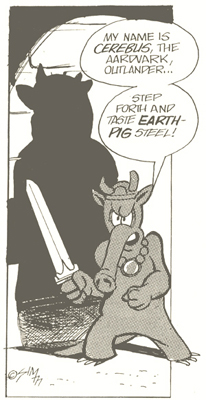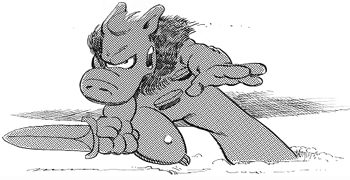A Funny-Animal Comic Book: Cerebus
Published on July 30th, 2008 in: Comics, Issues, Underground/Cult |By Christian Lipski
I am reading a funny-animal comic book called Cerebus.
That’s what I imagine people say when I try to explain what Cerebus is all about. There are so many questions to get past before you can really get down to why the epic is worth reading, but here are a few answers to those questions. . .
Yes, it’s a comic book.
It’s printed in black-and-white on purpose.
It has humor in it, but it’s not really a “funny” comic.
The main character is an anthropomorphic aardvark.
Yes, “anthropomorphic” is a long word.
It means “in human form”.
No, there aren’t a lot of long words in Cerebus.
No, uh. . . hey is that the time?

All images © Dave Sim
So let’s just accept and believe in a world where an aardvark walks and talks like a man. It was a funny joke at first, and intended as such: a Conan the Barbarian parody only with an aardvark as the hero! See the laughs? But as creator Dave Sim continued to write (and draw and publish) the story, the joke dropped away. Cerebus remained a walking aardvark, but grew as a person, with all the flaws of a well-developed character. There’s a depth of emotion in Cerebus that you don’t usually find in “sword and sorcery” stories, although the swords and the sorcery start to take a back seat to the human drama and intrigue after a while.
Margaret Liss, creator of the Cerebus Fan Girl and Cerebus Wiki websites and well-known fan of the series, considers Cerebus “one of the major achievements in the comic book field,” noting that it is “one continuous life story told by one creative team for 26 years.” During the 300 issues and 6,000 pages of Cerebus, Dave Sim travels through styles and genres that are usually the territory of their own respective books. The series begins with straight Conan-style swordplay, which lasts through most of the first “phonebook” (a descriptive term for the volumes of collected issues), although it blends in some brilliant parody of the follies of bureaucracy.
From there we move to political satire as Cerebus campaigns for office. That ends up in religious humor as Sim looks at the twists and turns of absolute power. Mixed in here is romance in the form of a love story that will twine throughout the series. There is commentary on the relationship between men and women; between a people and its government; between all of us and our creator. There are pokes at the comics industry, Thatcherian Britain. . . Cerebus even spends a great deal of time reinterpreting the Torah. Add in celebrity parodies, passages of straight text, and an appearance by Sim himself, and you get an idea of why the series can’t be summed up in a simple phrase.
Another joy of Cerebus is watching Dave Sim’s talents evolve. From a simplistic naïve style, his drawing progresses to being clean and precise even within the first phonebook. Characters become better-defined and clearer. It would have been tempting, I’d imagine, to have stopped reading the individual issues in the early stages of the title based on the artwork alone, but there’s a distinct joy in sticking with it, because it pays off.

All images © Dave Sim
Sim’s lettering also pays off; he has consistently won industry awards for his work in Cerebus. He pushed the envelope of what the presentation of words can say above and beyond the content of the words themselves. And most importantly, his writing improved visibly: starting off with simple, one-issue episodes, he expanded as he developed story arcs, ideas that took several issues (or several years) to come to fruition. As I reread the series for the fourth time and delve deeper into Sim’s own commentary on his work, I can see how incredibly detailed the “back story” of this universe is. Sim filled notebooks with the concepts and histories that form the backbone of the series. The events we see in print are only the surface of the full story.
During the writing of the series, Sim began using his editorial space to talk about issues that he felt were important. Halfway through the series, he began promoting the concept of comic creators publishing their own work, not being beholden to a corporate publisher. This was a scary concept, but not only was Sim doing it, he had already made the shocking declaration (in 1979) that he would self-publish three hundred issues. Sim was seen as the champion of self-publishing for the comics industry. He was also (and continues to be) a vocal supporter of the Comic Book Legal Defense Fund (CBLDF), which raises money to help defend people (and retailers) in the comic book industry from censorship.
Pages: 1 2
Time limit is exhausted. Please reload the CAPTCHA.